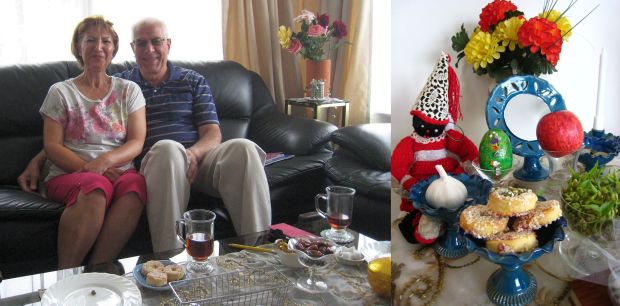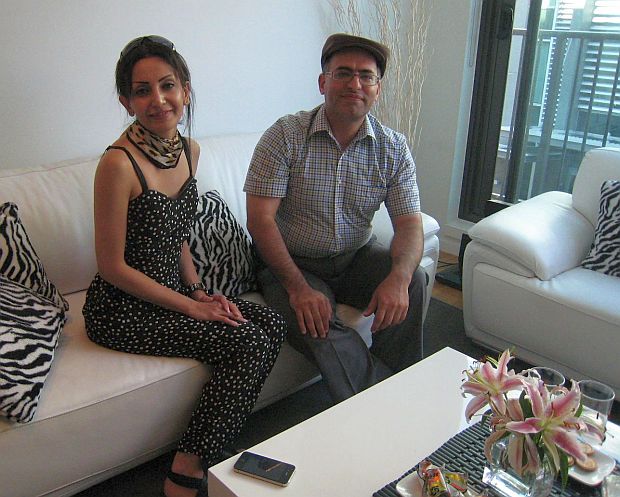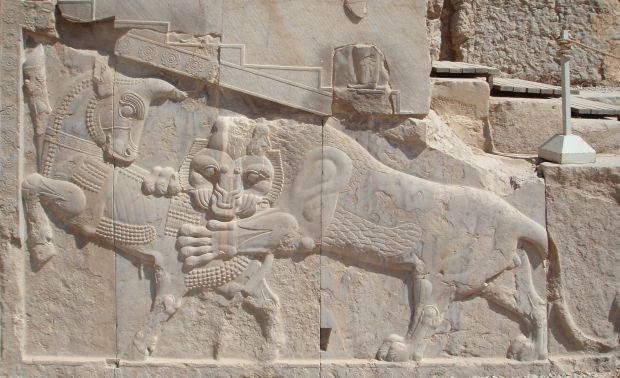
Parri and Khosrow's Haft Sin table
“It’s very important when you start New Year; all people kiss together and say Eide Shoma Mobarak! Happy New Year!”
– Parri Roshan Gohar
While many Western nations in the Northern Hemisphere greet the March equinox as a sign of the coming of spring, for countries across the Middle East, including Iran, the 21st of March heralds a New Year.
Originating in Persia and stretching back thousands of years, Nowruz combines religious and mystic elements to celebrate new life and beginnings. Although coloured with vestiges of Iran's Zoroastrian past, the Nowruz celebration is neither religious nor national in nature, nor is it an ethnic celebration. Rather, Jewish, Zoroastrian, Armenian and Turkish Iranians and Central Asians use the festivities of Nowruz to reflect the renewal of the Earth that occurs with the coming of spring. It has become so popular that the United Nation's General Assembly in 2010 recognised the International Day of Nowruz, describing it as a spring festival of Persian origin which has been celebrated for over 3,000 years.
Preparations for Nowruz begin a few weeks prior to the New Year with a traditional spring cleaning of the home. Known as Khouneh Tekouni, Iranians literally ‘shake the house clean’, washing their homes and carpets. It is also customary to buy new clothes and furniture during this time. On the night of the last Wednesday of the old year, Chaharshanbe Suri takes place. People gather in the streets and light small bonfires and jump over the flames. As they do so, they ask the fire to take away all the unpleasant things that had happened in the last year.
The figure of Haji Firuz also makes an appearance in the weeks leading up to Nowruz. Covered in soot and dressed in red, Haji Firuz dances through the streets playing a tambourine and spreading good cheer and heralding the coming New Year.
One of the most important activities in the celebration of Nowruz is making the Haft Seen table. Haft is the Persian word for the number seven and seen is the Persian word for the letter S. Literally, the haft seen table means a “table of seven things that start with the letter S’, symbolising the hopes for the successful and happy New Year.

Left: Parri Roshan Gohar and her husband Khosrow Jazayeri. Right: A close-up of Parri and Khosrow’s Haft Sin table, showing a Haji Firuz doll, traditional Iranian pastries, sabzeh or wheat, a sīb or apple and some sīr or garlic.
Although the custom has evolved over the centuries and may have regional variations, many of the items refer to the seven Zoroastrian immortals that guarded the sky, waters, earth, fire, plants, animals, and humans in ancient Persia. The Haft Seen items are:
- sabzeh – wheat, barley or lentil sprouts growing in a dish symbolising green environment, happiness and rebirth
- samanu – a sweet pudding made from germinated wheat symbolising affluence
- senjed – the dried fruit of the oleaster tree symbolising firmness, rigidity and tolerance
- sīr – garlic symbolising medicine
- sīb – apples symbolising beauty and love
- sumac – sumac berries symbolising patience
- serkeh – vinegar symbolising development and evolution
In addition, other symbolic items are also placed on the table including a mirror reflecting the year just past, live goldfish symbolising new life, coins for prosperity and hyacinth flowers symbolising spring. At the start of Nowruz, families gather around the Haft Seen table and wait for the exact moment the New Year arrives. Twelve days of celebrations are then held, with families visiting relatives and friends.

Tania Banihashemi and Farshad Safavi, two of the nearly 2,500 Iranians that now call Auckland, New Zealand, home.
The thirteenth day of Nowruz is known as Sizdah Bedah. Translated as ‘passing the bad luck of the thirteenth day’, Persian families celebrate outside with picnics accompanied by music and dancing.
Eide Shoma Mobarak!

Bas-relief in Persepolis. It is believed to depict a Zoroastrian element of Nowruz where in the day of a spring equinox, power of eternally fighting bull (personifying the Earth), and a lion (personifying the Sun), are equal. Photo: Ipaat at en.wikipedia (CC-BY-SA-3.0)

